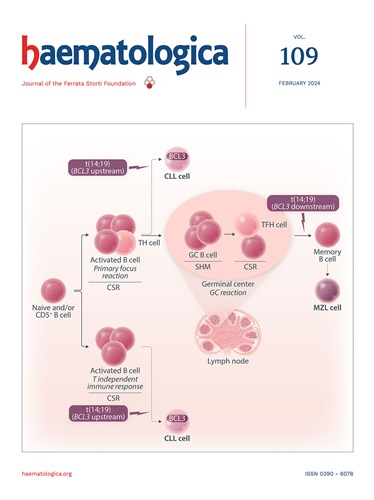Randomized trial of anti-thymocyte globulin plus low-dose post-transplant cyclophosphamide to prevent graft-versus-host disease in haploidentical transplantation.
IF 7.9
1区 医学
Q1 HEMATOLOGY
引用次数: 0
Abstract
The combination of anti-thymocyte globulin (ATG) and posttransplant cyclophosphamide (PTCy) appears to be a potentially effective graft-versus-host disease (GVHD) prevention strategy for haploidentical transplantation. However, the majority of the evidence originated from retrospective studies without uniform protocols. Our previous findings indicated that 10 mg/kg ATG plus low-dose PTCy could decrease GVHD among high-risk populations transplanted from maternal or collateral relatives. We designed an open-label, phase III, randomized controlled trial to compare patients receiving granulocyte colony-stimulating factor (G-CSF)/ATG-based haploidentical transplantation with or without low-dose PTCy (14.5 mg/kg on days 3 and 4) in nonmaternal, noncollateral haploidentical transplants from fathers, children or siblings. A total of 66 patients were randomly assigned to ATG-PTCy (n=44) or ATG (n=22) when the first interim analysis was performed. The interim analysis revealed that the 100-day cumulative incidences (CI) of grade II-IV (18.2% [95% CI 6.6-29.7] vs. 18.2% [1.7-34.7]; P = 0.996) and III-IV acute GVHD (2.3% [95% CI 0-6.7] vs. 0; P = 0.480) were comparable between the ATG-PTCy and ATG cohorts, as was chronic GvHD at 1 year. The estimated 1-year disease free survival (DFS) rates were also similar between ATG-PTCy and ATG cohorts (95.5% [95% CI 89.5-100] vs. 95.2% [86.6-100]; P = 0.979). These results suggested that ATG/PTCy (low-dose) had no advantage over 10 mg/kg ATG-based prophylaxis in patients with haploidentical transplantation other than that of maternal donors or collateral relatives. Future work needs to focus on identifying which populations might benefit from the combined strategy in the context of G-CSF/ATG-based protocols.抗胸腺细胞球蛋白加移植后低剂量环磷酰胺预防单倍体移植中移植物抗宿主病的随机试验。
抗胸腺细胞球蛋白(ATG)和移植后环磷酰胺(PTCy)的联合应用似乎是一种潜在有效的单倍体移植移植物抗宿主病(GVHD)预防策略。然而,大多数证据来自没有统一协议的回顾性研究。我们之前的研究结果表明,10mg /kg ATG加低剂量PTCy可以降低母体或侧支亲属移植的高危人群的GVHD。我们设计了一项开放标签的III期随机对照试验,比较接受粒细胞集落刺激因子(G-CSF)/ atg为基础的单倍体移植患者在接受或不接受低剂量PTCy (14.5 mg/kg,第3天和第4天)的非母系、非侧系父亲、子女或兄弟姐妹单倍体移植的患者。在进行第一次中期分析时,共有66名患者被随机分配到ATG- ptcy组(n=44)或ATG组(n=22)。中期分析显示,II-IV级的100天累积发病率(CI) (18.2% [95% CI 6.6-29.7] vs. 18.2% [1.7-34.7];P = 0.996)和III-IV期急性GVHD (2.3% [95% CI 0-6.7] vs. 0;P = 0.480)在ATG- ptcy组和ATG组之间具有可比性,慢性GvHD在1年后也是如此。ATG- ptcy组和ATG组的估计1年无病生存率(DFS)也相似(95.5% [95% CI 89.5-100] vs. 95.2% [86.6-100];P = 0.979)。这些结果表明,在单倍体移植患者中,ATG/PTCy(低剂量)与基于10mg /kg ATG的预防相比没有优势,而不是母亲供体或侧支亲属。未来的工作需要侧重于确定哪些人群可能从基于G-CSF/ atg协议的联合策略中受益。
本文章由计算机程序翻译,如有差异,请以英文原文为准。
求助全文
约1分钟内获得全文
求助全文
来源期刊

Haematologica
医学-血液学
CiteScore
14.10
自引率
2.00%
发文量
349
审稿时长
3-6 weeks
期刊介绍:
Haematologica is a journal that publishes articles within the broad field of hematology. It reports on novel findings in basic, clinical, and translational research.
Scope:
The scope of the journal includes reporting novel research results that:
Have a significant impact on understanding normal hematology or the development of hematological diseases.
Are likely to bring important changes to the diagnosis or treatment of hematological diseases.
 求助内容:
求助内容: 应助结果提醒方式:
应助结果提醒方式:


